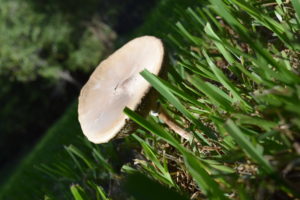COMMON NAME: Fairy Ring
SCIENTIFIC NAME: Over 60 species of soil-dwelling fungi
DISEASE DESCRIPTION
SYMPTOMS:
Although not considered to be particularly harmful, fungi that produce fairy rings can cause necrotic or dark green circular areas to develop in grassy areas. The necrotic areas occur when the fungus prevents water from penetrating to the roots via the formation of an almost impervious layer in the soil. The dark green areas occur due to the excess release of nitrogen during the decomposition of organic matter. Fairy ring formation in its most obvious form is the ring of mushroom fruiting bodies that can be anywhere from a few inches wide to 10 yards in diameter. The mushrooms show the extent of the fungal growth in the soil. Fairy rings typically occur annually, and the diameter of the ring will slowly increase over time as the fungus grows.
BIOLOGY:
 During the middle ages, it was believed fairy rings developed around fairies while they danced, but now we know they are the fruiting bodies produced by over 60 species of soil-dwelling fungi. These formations are circular because the fungal body grows radially, and produces mushroom bodies at the extremities of its growth. Fairy rings tend to be observed during spring and summer but are sensitive to moisture, temperature, and other environmental conditions and therefore do not always occur annually.
During the middle ages, it was believed fairy rings developed around fairies while they danced, but now we know they are the fruiting bodies produced by over 60 species of soil-dwelling fungi. These formations are circular because the fungal body grows radially, and produces mushroom bodies at the extremities of its growth. Fairy rings tend to be observed during spring and summer but are sensitive to moisture, temperature, and other environmental conditions and therefore do not always occur annually.
MANAGEMENT METHODS:
There are both chemical and non-chemical methods of addressing fairy rings. Chemical methods consist of soil fumigants applied by licensed pest control personnel, topical fungicide applications, or aeration followed by soil drenching with fungicides. Chemical methods are usually reserved for commercial applications rather than residential due to cost and difficulty in application. Non-chemical methods include removal of mushroom bodies for aesthetic purposes, improving the health of the grass by deep watering and fertilizing without excessiveness. Increasing frequency of mowing will hide increased growth of grass in fairy rings, or the sod and soil can be extracted and replaced. Also, reduce thatch buildup, remove tree stumps and roots to reduce organic matter, or add a fine layer of sand on top of the lawn to dilute the organic matter present. This reduction in organic matter removes food sources for the fungi possibly reducing the fairy ring.
RESOURCE LINKS*:
https://aggieturf.tamu.edu/wp-content/uploads/E-317-fairy-ring-factsheet.pdf
Factsheet on fairy rings. Discusses types of fairy rings and control methods. Also where the picture provided came from.
Fact sheet from extension. Discusses brief overview and identifying characteristics as well as peak occurrence.
Anecdotal publication on myths of fairy rings and some of the key facts about fairy rings.
This factsheet is authored by
Joseph Black
pursuing a Ph.D. in Entomology
Factsheet information for the plant health issues represented by the images on the 2020 TPDDL calendar were written by graduate students enrolled in the Department of Plant Pathology & Microbiology DR. DAVID APPEL’s Graduate level Introductory Plant Pathology course (PLPA601) in the 2019 Fall semester. This exercise provides an opportunity for a high impact learning activity where the students are tasked with producing an informational output directed to the general public. This activity provides an opportunity for the students to write and produce a (hopefully) useful product to communicate information on plant health issues to the public.
